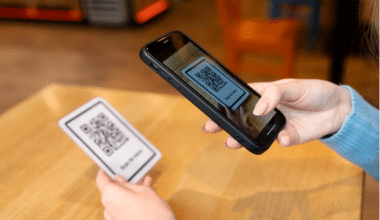Do you know the security key for your network? Furthermore, what exactly is a network security key? This login information, which is more frequently referred to as a Wi-Fi password, protects your private internet connection.
The password used to secure your network is known as a network security key. To connect your device to a Wi-Fi router in your home, you’ll need a code. The key to your network’s security is that Wi-Fi password. In this article, we’ll look at WiFi network security keys and how to find them on an Android phone and on Windows 10.
Network Security Key
A wireless network (or WiFi) password is another name for a network security key. It’s a digital signature that shields your network from illegal access and enables you to keep a secure connection open between users that want to use the network.
It gives you the ability to avoid the hazards of cyberattacks or information theft by securing a network and connected devices against unauthorized access.
Uppercase, lowercase, and special characters can be used to create a network security key when they are combined with a number. Make sure it doesn’t contain any easily guessed combinations, such as your name, the names of any loved ones, a number associated with your birthdate, or any other predictable aspects.
WiFi Network Security Key
Nobody wants to experience the nightmares that could result from their information being stolen through covert online means; everyone has heard horror stories.
That entails making investments to safeguard your data and privacy, which in turn requires considering how best to secure your wireless network at home. The WiFi network security key is useful in this situation.
I bring up the wireless network because, in modern households, practically all of the family members have access to a WiFi network that allows for quick information sharing and fast Internet access.
However, if you’re not tech-savvy, you might have a general understanding of why it’s critical to protect your privacy and data, but you might not be aware of how to accomplish it or what any of these terms represent.
We’ll also go into great depth on where to locate your WiFi network security key.
WiFi Protected Access
The WiFi-protected access (WPA) security technique requires a security key before the client may begin communicating with the network. Data exchanges are done in an encrypted way after the key has been verified.
There are three WPA iterations:
- WPA: It uses a per-packet key and temporal key integrity software to create a new 128-bit key dynamically when each packet arrives and assigns it to the same data packet. It prohibits unauthorized access and eliminates the threats that make WEP vulnerable.
- WPA2: It superseded WPA and put into practice the requirements of IEEE 802.11i, including support for the CCM protocol, an AES-based encryption option.
- WPA3: It requires AES-128 in CCM mode as the minimum encryption technique in WPA3-Personal mode and employs an identical 192-bit cryptographic strength in WPA3-Enterprise mode.
The wireless protected access security certification program uses the message integrity check to safeguard data against the possibility of tampering. It replaces the prior WEP-based cyclic redundancy check for error detection and correction.
It does feature a message integrity check, which protects the data against viruses that can change and resend the packets automatically. As a result, it takes the place of the WEP’s cyclic redundancy check for error detection and correction.
How to find the network security key on my Android Phone
Smartphones are incredibly beneficial for managing a business. You can manage the majority of your business from anywhere thanks to access to email, messages, the phone, the Internet, and apps. Also, you can enter network credentials and store them on your Android phone because it can access the Internet via Wi-Fi and cellular networks alike. You can quickly look up a network key on your phone if you forget it. To view the file with the saved network keys, you must have root access on your phone.
- Open your file manager from the app drawer with root access. The Google Play Store offers several file manager applications for root users, including ES File Explorer, File Expert, and Shady File Manager. These applications can be downloaded for free.
- After opening the “Data” folder, tap the “Misc” and “WiFi” folders.
- When the File Options dialog box appears, press “View as text” after tapping and holding on the “wpa_supplicant.conf” file.
- Scroll down to the SSID, which is the name of the network you want to locate. The word “PSK” is used to refer to the network’s key or password.
Network Security Key Windows 10
It is easy to locate the network security key for your wireless network if you are using Windows 10. Start by searching for the Control Panel in the Start menu. Additionally, it is accessible from the Settings menu. Select Network and Internet from the Control Panel once you’ve arrived there. Select Network and Sharing Center from there.
Next, pick “Change adapter settings” from the menu. To check your connection to the wireless network, right-click the adapter and select “Status”. Select the “Wireless Properties” button in the text box. The security tab will then be shown in a window for your review. You can locate the network security key on this tab. The “Network Security Secret” or “Wireless Key” will be listed.
You can use the network security key to access your wireless network on Windows 10 once you’ve located it. The network security secret may occasionally need to be generated using a passphrase. You will be required to enter the passphrase you chose while configuring the wireless network. The Network Security Key will appear in the Wireless Properties box of your Windows 10 after you have inputted the passphrase and clicked OK.
On a Windows 10 PC, there are a few easy actions you must take to identify the network security secret.
- By holding down the Windows key and I, the Settings window will appear.
- Select “Network & Internet” from the menu.
- From the navigation menu on the left, select the “Status” tab.
- Select “Network and Sharing Center” from the menu.
- The “Wi-Fi” option can be found in the left menu.
- The “Wireless Properties” button should be clicked.
- Select “Security” from the tabs.
- In the text box below, the “Network Security Secret” will be visible.
Your wireless network connection is authenticated and secured using a password called the Network Security Key. Because it might be exploited by unauthorized individuals to access your wireless network and any data kept on it, it is crucial to keep your network security secret. To maintain your network’s security, it’s crucial to make sure that the network security key is updated and changed frequently.
How to find network security key on iPhone
An essential component of protecting your iPhone from unwanted attacks is network security. It aids in preventing unauthorized individuals from accessing your personal information. You must adhere to a few straightforward instructions to locate the network security secret on your iPhone.
- Get your iPhone’s “Settings” app open.
- Make sure “Wi-Fi” is turned on by tapping on it.
- You can connect to a Wi-Fi network by tapping on its name.
- You can find the network security key by scrolling to the bottom of the page.
You can reset the Wi-Fi network from the router if you are unable to find the network security key or have forgotten it. To achieve this, you’ll need to be aware of the router’s password. The security secret can then be found in the iPhone’s Wi-Fi settings after the network has been restarted.
The network security key must never be disclosed to anyone, it is crucial to highlight. System security secrets aid in ensuring the safety of your data, which is crucial.
Where can you find your network security key?
You can check your router directly if you have it handy. Its exterior should contain the password someplace, frequently printed on a little sticker. Check the router’s box or the instructions that came with it if the password isn’t readily apparent there.
However, it’s extremely normal to store your router someplace out of the way where you won’t see it. If you want to give the password to someone else, you can instruct them to do the same. You don’t want your visitor to have to scrounge around behind the couch to find it.
There is a better approach. The network key will already be saved on your computer if you are connected to the wireless network. As soon as it comes into range, it may connect automatically, and you can access the data on your device as a result.
#1. On a modem or router
The terminology is likely to be your first point of confusion. Is a password the same as a network security key? They effectively serve the same purpose, yes. Even if you discover the label on your router, you might not know what you’re looking at because each ISP and manufacturer will use a somewhat different language.
Other terms for network security keys include:
- Network
- WPA Key
- Wireless password
- Password
You can immediately link yourself and other people after locating the router and discovering the network security key on the hardware.
#2. Android and iPhone smartphones
On an Android phone, finding your network key takes just a few seconds. However, bear in mind that depending on the brand you’re using, these instructions may differ significantly.
- Open “Settings,” select “Connections,” and then “Wi-Fi.”
- Press the current network button.
- To view your WiFi password, scan the QR code.
How to locate a network security key on an iPhone is as follows:
- Click “Settings” and then “Wi-Fi.”
- Your network is next to an “i” icon. Tap it.
- Copy the IP address of your router and type it into your browser.
- Enter the login information for your router to view the password.
#3. Using a Windows 10 computer
It’s easy to obtain the saved login information if you already have a computer connected to Wi-Fi but are unable to locate the wireless network key for whatever reason. There are seven straightforward procedures for Windows 10 users.
- Press the Start button.
- Tap Network Connections.
- Press the Network and Sharing Center button.
- On the Wireless network icon, click.
- For wireless properties, click.
- Activate the Security Tab.
- To make the network security key visible, select Show characters.
- Using macOS
It follows a similar procedure for anyone using a Mac. This process should take less than a minute if you are aware of the name of your Wi-Fi network.
- Launch the search engine.
- Access keychain search.
- Look for your Wi-Fi network in the Keychain Access panel.
- On your network, click.
- To make the network security key visible, select Show Password.
- To verify your access privileges, enter your Mac password.
How to fix the error “network security key mismatch”
There is a good chance that you are using the wrong password when you attempt to log into your wireless network and receive a network security key mismatch error. But that isn’t the only explanation. Other potential causes include using the incorrect security mode, running antivirus software, or using outdated wireless drivers.
Use the common techniques listed below to correct the error.
- Verify your password’s accuracy and that it contains the prescribed mix of uppercase and lowercase characters. Check the keyboard’s caps lock key before typing, then do so.
- Make sure that your device is compatible with the Wi-Fi network version to which you are attempting to connect. When you connect the device to an unsupported network, you may occasionally see a network security key mismatch error.
- If your device still displays a mismatch message after entering the correct password, try restarting the computer or device. The gadget may hang occasionally; rebooting it will usually fix the problem.
You can alter the security protocol being utilized if the issue continues. If you’re currently using WEP, for instance, switch to WPA or WPA2. - To fix the network security key mismatch problem, you might also stop your third-party antivirus client or upgrade your wireless drivers.
Why won’t my laptop connect to my WiFi?
One of these explanations could be that the router is down, you entered the wrong password, your laptop is too far away from the router, or your device may not be compatible with the Wi-Fi network you are attempting to connect to.
Why is my router asking for a network security key?
Network security keys have only one goal: to guard against unauthorized use of a wireless network or device. Network security keys facilitate the establishment of a secure connection between the network, routers, etc., and the authorized user.
Summary
We now understand the idea of a network security key and its numerous types thanks to this guide. Also, we have shown how a network security key can be used in a variety of networking contexts and with a variety of network devices.
We now know several helpful techniques for fixing the security key mismatch problem as well as quick configuration instructions for Windows PCs, routers, and Android phones.
Related Articles
- Mesh Wifi: The Answer to All Your Internet Connectivity Woes
- 5 Top Features To Look For When Buying A Mobile Wi-Fi Hotspot
- 10 BEST ELECTRIC DOOR LOCK: Complete List Smart & Reliable Door Locks
- AT&T INTERNET BUSINESS: What Is It, Availability & Services
- PASSWORD MANAGEMENT TOOLS: What It Is, Pros and Cons, and All You Need to Know






